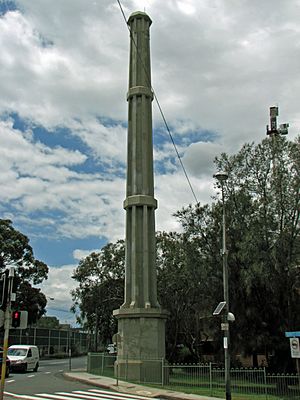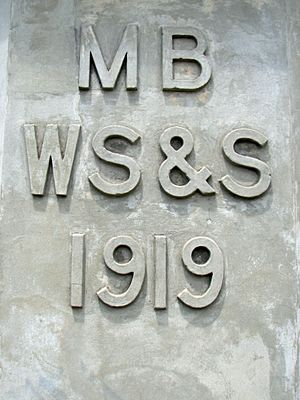Burwood Sewer Vent facts for kids
Quick facts for kids Burwood Sewer Vent |
|
|---|---|
| Lua error in Module:Location_map at line 420: attempt to index field 'wikibase' (a nil value). | |
| Location | Railway Parade, Burwood, Municipality of Burwood, New South Wales, Australia |
| Built | 1919 |
| Architect | Metropolitan Board of Water Supply and Sewerage |
| Owner | Sydney Water |
| Official name: Burwood Sewer Vent; Wentworth Road Sewer Vent; Railway Parade Sewer Vent | |
| Type | state heritage (built) |
| Designated | 15 November 2002 |
| Reference no. | 1638 |
| Type | Other - Utilities - Sewerage |
| Category | Utilities - Sewerage |
| Builders | Metropolitan Board of Water Supply and Sewerage |
The Burwood Sewer Vent is a special tower in Burwood, Sydney. It helps air out the city's sewer system. Think of it like a giant chimney for underground pipes! This tall structure is also known as the Wentworth Road Sewer Vent or Railway Parade Sewer Vent.
It was built in 1919 by the Metropolitan Board of Water Supply and Sewerage, which is now Sydney Water. The vent is considered an important historical site. It was added to the New South Wales State Heritage Register in 2002.
Why Was the Burwood Sewer Vent Built?
This vent is part of Sydney's early sewer system. Back in the late 1800s and early 1900s, Sydney was growing fast. New sewer lines were needed to keep the city clean. The "Main Western Carrier" and "Western Branch Main Sewer" were big projects. They helped carry wastewater away from homes and businesses.
The Burwood Sewer Vent was built in 1919. It was needed because of a new problem. A large slaughterhouse, called the Homebush Abattoir, opened in 1916. The gases from this facility were very strong. They caused damage to the sewer pipes. So, vents like this one were built to release these gases safely into the air. This helped protect the sewer system.
Even before these big sewer lines were finished, local councils like Burwood wanted a proper sewage system. They were told to wait for the larger Western Suburbs Sewer project. This shows how important these vents and sewer lines were for public health.
What Does the Burwood Sewer Vent Look Like?
The Burwood Sewer Vent is a tall, strong structure made of reinforced concrete. It was built in 1919. It looks a lot like another vent in Croydon.
The vent has an eight-sided base, called a pedestal. This base is about 5.5 meters (18 feet) tall. On top of the base is a round shaft. This shaft has concrete ribs and two eight-sided concrete bands running up its length. Near the top, it has decorative brackets and a projecting ledge, similar to old buildings.
The entrance door is on the south-east side. It's an original steel door set into a concrete frame. You can see some signs of past repairs on the shaft and base. There's also some damage from rust on the southern wall of the base.
The vent stands out in the area. It's located at the corner of Wentworth Road and Railway Parade. Nearby, you'll see modern apartment buildings and the railway line. The ground around the vent is clear. It's part of a small open space. A lightning rod is attached to the vent to protect it from storms.
Overall, the concrete vent tower is mostly in its original condition. It's in fair shape, but it does need some care for its doors and concrete.
Why is the Burwood Sewer Vent Important?
The Burwood Sewer Vent is listed on the New South Wales State Heritage Register. This means it's a protected historical site. It's important for several reasons:
- It shows history: The vent is a clear link to the early sewer system in Western Sydney. It also reminds us of the problems caused by gases from the Homebush Abattoir, which are no longer an issue today.
- It's a landmark: The vent stands tall at a busy intersection. Its unique design makes it a well-known feature in the local area.
- It's valuable to the community: Local people likely see the vent as an important part of their neighborhood. They value its function and its role as a local landmark.
- It helps us learn: The vent shows how sewer systems worked in the past. It helps us understand the history of public services in New South Wales.
- It's rare: This vent has a very unusual design and was built using reinforced concrete. It's one of only two like it in the entire Sydney Water system. This makes it quite rare in New South Wales.
- It represents its type: The vent clearly shows the important job that sewer vents play in keeping our cities clean and healthy.



